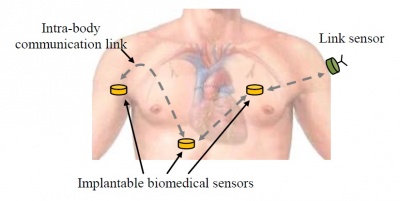Passive and Self Sustaining Receivers For On and Intra Body Communication For Wearable Sensors Networks
From iis-projects
Today Wearable sensing devices are gaining popularity, with people wearing everything “smart” from clothing to glasses and watches. Nowadays wearables are battery-powered and a critical issue is the limited lifetime and communication is one of the most power hungry subsystem. Commercial and academic wearable devices are using today a Bluetooth interface to communicate, but this is not the optimal solution as also the new generation of low energy bluetooth are consuming a lot of power and due to the difficulty of the RF signal to pass through a humans' bodies. This causes an effect called "path loss" whereby a signal is weakened on the way to its destination, as well as causing security worries due to the distance the signal travels around the user being susceptible to eavesdropping. Many novel approaches today are trying to overcome this problems try to use on or intra-body communication. This project has the main goal on the design and implementation of an ultra low power receiver for this kind of communication. The project will also focus on how make the whole system self-sustaining using RF energy harvesting or other kind of energy harvesting suitable the the specific application scenario of body wearable sensor node.
Depending on the applicant's profile and project type, his tasks may involve some of the following:
- lab. testing/characterization of the existing prototype: verification of the prototype's characteristics w.r. design specification (simulations), measuring power-consumption, and assessing detection performance in lab. conditions
- programming the circuit (microcontrollers) for specific application, field testing.
- printed circuit-board design to make it suitable for the receiver and sensor part.
picutre reference : Zhang, Kai, et al. "Modeling and characterization of the implant intra-body communication based on capacitive coupling using a transfer function method." Sensors 14.1 (2014): 1740-1756.
Contents
Status: Available
- Looking for Semester and Master Project Students
- Supervisors: Michele Magno
Prerequisites
(not all need to be met by the single candidate)
- experience using the laboratory instrumentation - signal generators, oscilloscopes, DAQ cards, Matlab etc.
- analog electronics and signal conditioning with operational amplifiers: amplifiers, filters, integrators etc.
- knowledge of microcontroller programming (C, preferably CC2650 but it is not mandatory)
- basic knowledge on signal processing is a plus.
- plus is knowledge on printed circuit board (PCB) using Altium.
Character
- 30-40% Theory
- 30-40% Implementation
- 20-40% Testing
